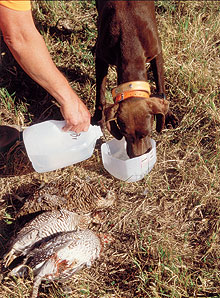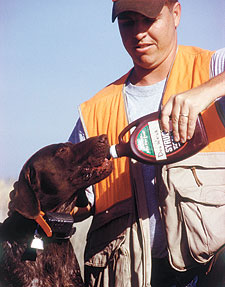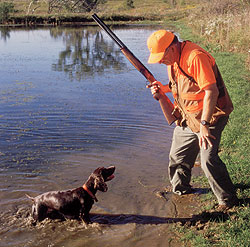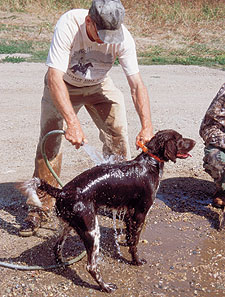Dealing with heat stress, heat stroke and other weather-related issues
By Jerry Thoms
 Water is the key to keeping a hot dog cool when exercised during warm weather. A gallon-size plastic jug will hold enough to last for an hour when the air temperature may be in the 70s while ground temperature where dogs hunt might be in the 80s or 90s. |
When Molly, Jack Delaney's three-year-old black Lab, started to stagger, she was obviously in some sort of serious distress.
Delaney and his dog had been hunting pheasants on opening day of the season in a mile-long strip of cattails that ran along a big field of standing corn. "I had expected water to be in the slough; however, the vegetation was bone dry. But water didn't seem to be a problem since the temperature was in the mid 60s and the air felt fairly cool," Delaney recalls.
At the end of the slough on a gravel road, Molly laid down in the shade of the cornstalks. With her tongue hanging way out, her eyes glazing over, and her breathing coming in huge gasps, Molly could no longer walk.
That's when Jim Rieser came down the road in his pickup, saw the Lab and her owner in the ditch and stopped to give some help. As a veterinarian, Rieser was quick to spot a dog experiencing heat stress. "The Lab was on the edge of hyperthermia, a dangerous condition which if not treated could lead to major organ damage and even death," Dr. Rieser says.
With a gallon jug of water in hand, Rieser first tried to get Molly to drink but she was panting so hard she couldn't swallow. "A real bad sign," Rieser notes.
So, next, Rieser poured water on the dog to cool her down, a crucial step in treating any dog for heat stress. "Start at the head with water in the mouth, on the tongue and on the ears, then move on to the throat region where the blood flow is close to the skin surface.
After that, soak the paws and belly and rub water into and through the fur whether on a long- or shorthaired dog to ensure that there is contact with the skin," Rieser emphasizes.
The idea was to get Molly's body temperature back to normal as soon as possible. After 30 minutes of rest, relaxation, and plenty of water on the outside and a little on the inside (she finally did take a drink), Molly appeared to have recovered enough to get up and move around.
"No way," was Rieser's response, however, to Delaney's plan to hunt Molly across the cattails and back to his vehicle parked nearly a mile away.
Take Any Heat Stressed Dog In For A Blood Test
"Put Molly in my truck and I'll take both of you back to your vehicle. Don't hunt Molly any more today," Rieser advised. "And to be on the safe side, I recommend you take her to your vet for a blood test to see if any damage has been done to her brain or kidneys," he added, making clear the seriousness of the Labrador's condition. With Molly lying on the truck floor in front of the vehicle's air conditioner, Dr. Rieser gave the dog's owner further advice on how to deal with the case of serious canine heat stress.
"A blood test at the vet's clinic will indicate the degree to which the overheated dog has experienced possible impairment in its mental capacity or organ function. Heat stroke is a destructive force that can kill brain cells and destroy a dog's kidneys, heart, intestines, and liver.
"In some cases, if the heat stress has been severe, a veterinarian will give fluids intravenously to further cool off a dog's system and to put the blood back into balance," Dr. Rieser adds.
 Any gun dog can learn to drink for a squirt bottle. Carried in a game vest, these bottles can hold enough water to keep a hot dog hydrated as a means of avoiding heat stress. Commercially produced re-hydration products are available to replenish lost liquid, minerals, and vitamins in overheated canines. |
Heat Stress Versus Heat Stroke
Everyone who owns a gun dog has had a hot dog that runs with its tongue out while panting heavily and sucking up water from a puddle or a water dish at every opportunity.
And though we all try to avoid letting our dogs get hot to the point where they may lie down and quit working for us, sooner or later most all of us will be faced with the reality of heat stress and the possibilities of heat stroke.
"I really don't like to make a distinction between heat stress and heat stroke," Dr. Rieser says. "That's because the hard panting, the gulping of water, and the wallowing in water that is part of a dog's behavior when stressed by high heat and excessive exercise is also a prelude to heat stroke. So by the time a dog's owner has decided on the difference, a heat stroke calamity may have already occurred," Rieser warns.
In both heat stress and heat stroke conditions, heavy breathing, a rapid heartbeat, physical disorganization, and mental disorientation can take place as the respiratory system tries to cool down blood temperatures. "When a dog's body temperature hits 105 degrees, oxygen depletion takes place. At that point, there is a narrow window of opportunity for the blood temperature to be brought down and possible recovery to occur," Rieser explains.
"At 108 degrees, however, body cells get so hot they literally explode and permanent damage can take place in the brain, liver, gastrointestinal tract, the heart, and kidneys," Rieser points out. "That's why a dog suspected of having heat stroke needs to be cooled down with water, ice packs, and plenty of air to dissipate excessive heat."
Water is the key to a quick cool down but fast evaporating rubbing alcohol will also help to pull heat from the body. "Don't force water down a dog's throat because this won't necessarily cool the dog and can instead cause air to be ingested, which may lead to stomach bloat. And whatever you do, don't transport a hot, wet dog in a poorly ventilated dog box or crate because without enough air circulating through these enclosures they can turn into saunas, making things even worse," Dr. Rieser warns.
Once a dog is in the clinic or hospital, most vets will treat possible heat stroke with intravenous fluids to bring hot blood and body temperatures back to normal and to replenish lost liquids. Some veterinarians will inject steroids as a way to counter continuing cell damage. In every instance, p
ossible heat stroke will be regarded as a life threatening situation.
Plan Your Hunts Carefully
Hunting seasons seem to be hotter nowadays than in the distant past. Whether the cause is global warming or something else, the fact is that the opening day of pheasant or waterfowl season, which may have once produced snowflakes, is currently more likely to have temperatures in the 70s and 80s. "Even apparently moderate temperatures in the 50s and 60s can be dangerous for a dog running in heavy cover such as dried cattails or thick prairie grass," says Will Stone, a hunting lodge owner from Gary, South Dakota.
Stone once measured the temperature a foot off the ground in a food plot where his Brittany had been running. "Six feet up where I was standing and the wind was blowing, the thermometer read 68 degrees. Down where the dog was hunting and no breeze could be felt, the temperature was 80 degrees — no wonder my dog was nearly walking on her tongue and drank so much water!
 During hot and dry spells when hunting upland game birds, a gun dog owner might plan the path of the hunt according to where the water is. Natural sources such as ponds, creeks, rivers, and lakes can be places where a dog can get a drink and take a dip to stay cool, but make sure the water is algae-free and not likey to contain farm run-off. |
"Now that I realize how hot the temperatures can be down where a dog is hunting, I'm a lot more careful about letting my Brittanys stay in the field too long on even mildly warm days," Stone says.
Plan to hunt early and late, in the cool of the morning or toward the end of the afternoon, if possible. Also, plan to hunt areas with natural water supplies such as creeks, rivers, ponds or lakes. "And if natural sources of water aren't available, create your own supply.
On our farm, we put out a kid's swimming pool filled with fresh water every day so any dog can get a drink or take a dip any time," Stone adds.
Beware Of Natural Water Sources
Watch out for water found in puddles, ponds, dams, creeks, and rivers, especially when hunting a dog during extremely dry conditions, warns Jim Keller, an Irish setter owner from Lincoln, Nebraska.
"During hot spells when water levels fall, some potential toxic farming chemicals can concentrate in small areas and some strains of poison-producing algae will grow when the temperatures are high," Keller says. "Drinking this water can make a dog sick and maybe kill it. Even a dog that just walks through this stuff and licks its paws later might be affected."
Waterfowl Dogs Still May Need Water
Gun dogs that hunt waterfowl in water usually don't need water brought from home to stay cool or quench their thirst. But dogs that hunt geese and ducks in dry fields, especially early in the season, definitely need access to water for a drink and a drenching.
Early season Canada goose seasons in particular can range from warm to hot, so don't forget water for the dogs on these hunts.
Bring Water From Home
Though many gun dogs will drink dirty water from a ditch and suffer no apparent ill effects, those same dogs might drink treated water from a municipal water supply and get sick or nearly die from the added chemicals. Symptoms might include everything from constipation to diarrhea. So to avoid water sensitivity issues, many traveling hunters take water from home to keep their canines hydrated.
Better Ways To Haul Water
Gallon jugs made from plastic are popular for hauling dog water because they are easy to carry and to use as well as inexpensive and expendable. A portable water dish, cut from the bottom half of a plastic milk jug, will neatly rest under a whole jug and pop off when needed.
Five-gallon plastic jerry cans with spouts or spigots cost around $8 to $10 and are useful for hauling and dispensing water. Big metal multi-gallon tanks built onto upscale dog trailers are the ultimate for carrying large quantities of water for a large number of canines on a training day or on a cross country hunting trip. A "Water Tube," offered by Lion Country Supply, is made from four or six inch diameter pvc pipe five feet in length.
The Water Tube, which holds three or seven gallons, can be mounted to the inside rail of a pickup truck box and has a two way brass faucet for taking on and dispensing water.
For carrying dog water in the field, an inexpensive and compact plastic chocolate syrup dispenser can be dropped into a game vest and will hold 16 ounces of water that can be squirted from a pull-out and push-in spout. A more sophisticated product for transporting water on a long walk in dry country is the Quilomene "Upland Bird Hydration Vest."
 Water on the outside of a dog is a key factor in avoiding heat stress because a wet canine is usually a cool canine. Thoroughly soak the fur and rub water into and through the coat to ensure skin contact. For dogs on the edge of heat stress, pour water on its tongue (especially if the dog won't or can't drink), ears, throat, belly, groin, and back. |
This product has all the standard gear and game toting features of a conventional vest plus a built in pliable plastic bladder that will hold more than a gallon of water that is dispensed from a half-inch diameter tube.
A Hot Dog On Ice
Use a bag of ice cubes to quickly cool down any dog panting hard, acting disoriented, and seeming to be on the edge of heat stroke. "Ten pounds of ice cubes dropped onto the floor of a plastic dog crate will create an instant opportunity for a dog to get in and stand on the ice or lie down on it if necessary," suggests Dr. Jim Mc-Knight, a veterinarian from Brookings, South Dakota.
"Most plastic crates as well as some metal crates will have a waterproof floor that will act as a reservoir so as the ice melts cold water will be available for the dog to stand in, lie in or drink," McKnight points out. Should there be a concern about a hot dog experiencing shock from over-exposure to the ice and cold water? "I've never seen a problem with shock. Each dog usually decides how much ice and water it wants and will walk away if the cold gets to be too much," McKnight says.
Commercial Supplements
Commercially-manufactured supplements are available designed specifically to aid a canine in absorbing water and to provide lost electrolytes, minerals, vitamins, anti-oxidants, and other substances contributing to a heat stress condition. In liquid form (to be given directly
to a dog), these products claim to promote hydration and water intake as well as to reduce overheating and boost muscle energy. Ingredients in many of these products include potassium, sodium chloride, zinc, and vitamins A, D, E, and C.
"Proving that these supplements work as advertised is difficult because so many variables enter into a scientific test of these products," notes Dr. Woody Franklin, a veterinarian from Brookings, South Dakota. "But in theory, there is some substance to the concept.
And nothing in the list of ingredients appears to be harmful to canines in general. So for anyone interested in these supplements, there is no good reason not to try them."
Additional Suggestions
Preventing canine heat stress requires plenty of water, obviously on the inside but also on the outside of any hot dog during an exercise or training session or on a hunting trip. On a day with temperatures in the 60s or higher, most any breed, size, or age of gun dog can drink a gallon of water in a couple of hours of intense activity.
Likewise, water should be poured on all gun dogs before, during, and after any sort of extreme physical activity when the temperatures are 50 degrees plus, there is little air circulation, and the cover they are working is heavy and hard to run through. Add another gallon or more per hour for this external cooling process.
Another way to avoid heat-stressing a dog is not to hunt in the hottest part of the day but to instead go early or late when temperatures are more moderate. "On opening day of the pheasant season when the thermometer can be in the 70s or 80s, we hunt until 11 a.m., then take a long break until 5 p.m.," says Tom Dokken from Northfield, Minnesota. "This plan has actually improved our success rate because the dogs are fresh and work hard in the morning then get a long rest until late afternoon."
Conclusion
Every hunting season many gun dogs get hurt from heat stress and some die from heat related strokes that destroy mental function and devastate the renal system. But it's a problem that can be avoided with common sense and quick action — above all, don't hesitate to stop hunting your dog immediately and begin cool-down procedures if he starts exhibiting any of the symptoms described above.
Some Handy Guidelines For Keeping Your Pooch Cool
- Always carry plenty of dog water in your vehicle and in your hunting vest, no matter what the apparent temperature. Haul water in one-gallon jugs and five-gallon cans for on the road and in a smaller, portable container for in the field. Also carry several pounds of ice in a chest-type cooler for emergency canine cool down.
- Never assume that natural supplies of water (cattle dugouts, ponds, or creeks) will be in the field (in hot weather these sources can dry up) or that the water found in these places is good (in dry spells, toxic farm chemicals can concentrate there or poisonous algae can grow there).
- Get water into and onto a gun dog at every opportunity. Wet down all dogs before, during, and after an exercise or training session. And of course, follow this same procedure on a hunt.
- When the breeze seems cool on your face, assume that on the ground where your dog is the temperature may be much hotter with little air circulation. So, keep your hot gun dog well hydrated on the inside and outside all day.
- When the weather is hot, hunt, exercise, and train your gun dog early or late in the day to avoid high temperatures. Usually the hunting is better then anyhow and your dog will always perform better in cooler conditions.
- Recognize the signs of canine heat stress, such as excessive panting, glazed eyes, ignoring commands, staggering, and falling down without an ability to get up.
- Treat all heat stress as a serious condition that can disable and may kill any dog no matter what breed, general health, or age. Assume that a heat stressed dog may need medical attention which includes an immediate trip to a veterinarian for an examination and treatment.
- A heat stressed dog needs to be immediately cooled off with water in its mouth (don't force a dog to drink if it doesn't want to or can't), on its ears, neck, belly, back and groin area. Squeeze water into the hair and down to the skin to assure that cooling contact occurs.
- When transporting a heat stressed dog in a crate or a dog trailer, make sure plenty of ventilation is available to keep the canine container from turning into a deadly sauna. Best of all, put a hot dog in the vehicle in front of the air conditioner.
- Put ice cubes in your dog's crate as an insurance policy that cool water will always be available when traveling down the road or sitting still on a hot day. Consider the use of commercially-made products specially designed to replenish lost liquid, minerals, and vitamins — sort of like Gatorade for dogs.






